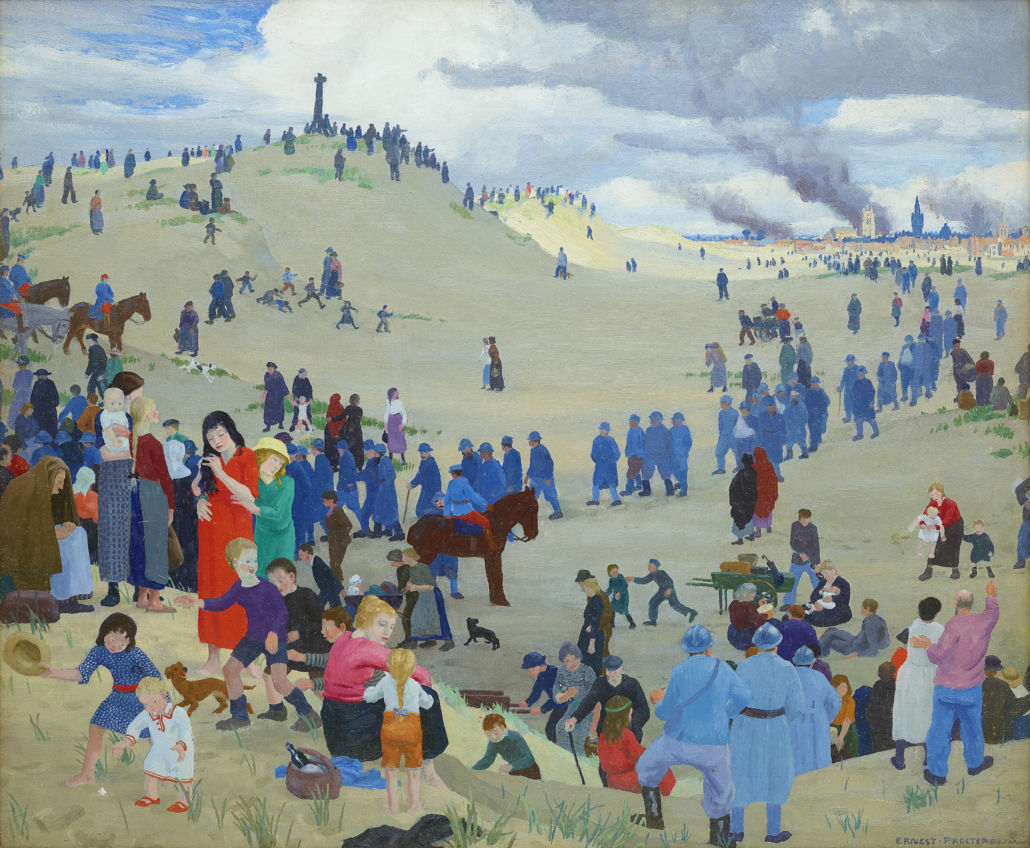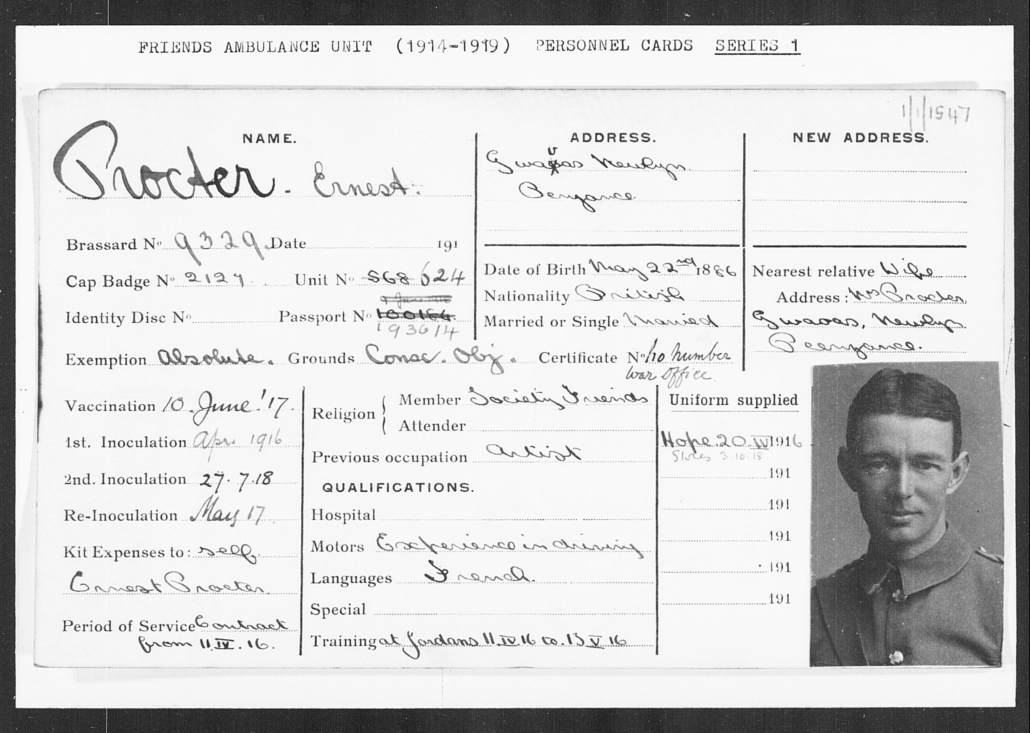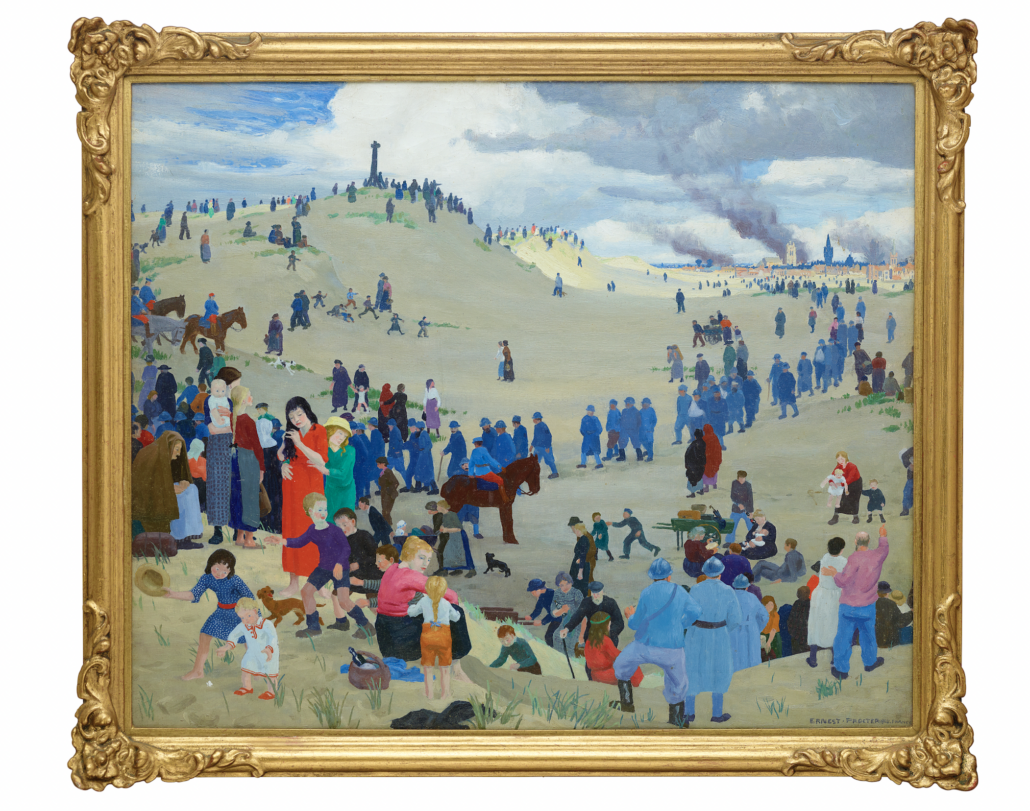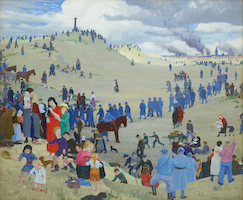
EDINBURGH, U.K. – Best known for allegorical figure compositions and landscapes, British artist Ernest Procter (1886-1935) made relatively few major oil paintings of war subjects. However, a long-lost major work, The Long Range Bombardment of Dunkirk, comes to auction this month. Recently emerged from a private collection, it is estimated to bring £10,000-£15,000 at Lyon & Turnbull’s MODERN MADE auction in London on Friday, April 29. Absentee and Internet live bidding will be available through LiveAuctioneers.
Born in Tynemouth into a Quaker family, Procter had declared himself a conscientious objector on the outbreak of World War One. However, in 1916 he joined other young Quakers in The Friends’ Ambulance Unit established as a means for ‘civilians’ to contribute to the war effort in a non-violent way. Procter arrived in Dunkirk on June 12, 1916 and served in France until he was demobbed in February 1919, his duties including care of the wounded, ambulance maintenance and quartermaster tasks.

Recording his experiences in sketches, drawings and paintings as circumstances permitted, in the last days before armistice, Procter successfully applied to the Ministry of Information for a permit to officially depict the work of the Red Cross on the Western Front. The six finished watercolors acquired by the ministry are now in the collection of the Imperial War Museum alongside a number of Procter’s wartime drawings and a sketchbook.
Although probably painted in the artists’ enclave of Newlyn, where Proctor and his wife Dod spent many years, Long Range Bombardment of Dunkirk is an eyewitness account of the major German offensive which took place during March 20-23, 1918.
Worked up from notes and sketches made on the spot, it depicts the havoc caused as shelling from a German gun sited 20 miles away from the city prompted residents – soldiers and civilians – to flee. In vibrant color and in great detail, Proctor depicts the Dunkirk dunes strewn with the refugees and members of the military that stream away from the city as it burns in the background.
The importance of the painting was recognized as early as April 1919, when it was reproduced in color and singled out for extensive praise in an article about Ernest and Dod Procter in Colour magazine.

Ernest Procter, ‘The Long Range Bombardment of Dunkirk,’ shown in its frame, est. £10,000-£15,000
Lyon & Turnbull senior specialist Alice Strang, who did much of the research to uncover the picture’s full history, said: “The picture was discovered by my colleague during a valuation in a private residence. To recognise the scene as Dunkirk – rather than Ypres as long thought – was the first important piece of the puzzle. Our enquiries at the Tate and the Imperial War Museum had returned little but we found reference to a work of this subject in the 1990 catalog for the Procter exhibition at the Laing Gallery in Newcastle. It included a note about a work pictured in the journal ‘Colour’ in 1919. Luckily, the National Library of Scotland holds copies of ‘Colour,’ and it was a tense 24 hours whilst I waited for the journal to be sourced from Special Collections. It was extremely exciting to turn the page and see an image of the exact work I was researching illustrated, confirming we had found this long-lost acclaimed piece. Further research also led us to uncover the personnel record of Ernest Proctor as ambulance driver through an online Quaker archive, confirming he was present in 1918 as the bombardment took place. It was clear that this work by Proctor had a significant impact at the time he presented it and its power has not faded. Proctor’s depiction of the terrible impact of warfare on civilians is one that, with great sadness, remains all too current.”
[av_button label=’Click to view the auction catalog and sign up to bid’ icon_select=’no’ icon=’ue800′ font=’entypo-fontello’ link=’manually,https://www.liveauctioneers.com/catalog/243713_modern-made/?keyword=&page=1′ link_target=’_blank’ size=’small’ position=’center’ label_display=” title_attr=” color_options=” color=’theme-color’ custom_bg=’#444444′ custom_font=’#ffffff’ btn_color_bg=’theme-color’ btn_custom_bg=’#444444′ btn_color_bg_hover=’theme-color-highlight’ btn_custom_bg_hover=’#444444′ btn_color_font=’theme-color’ btn_custom_font=’#ffffff’ id=” custom_class=” av_uid=’av-7opanzm’ admin_preview_bg=”]
The current rate of exchange is £1 = US$1.24.
View top auction results on LiveAuctioneers here: https://www.liveauctioneers.com/pages/recent-auction-sales/


